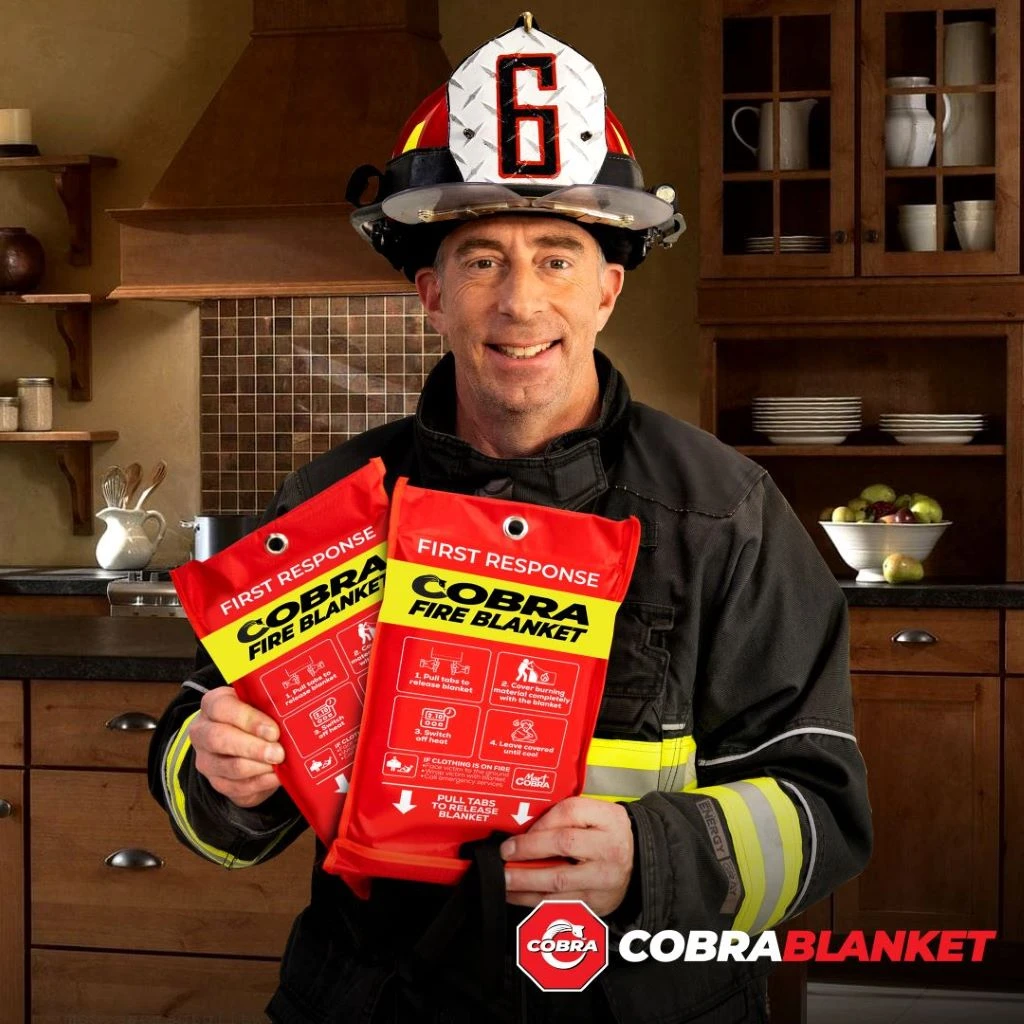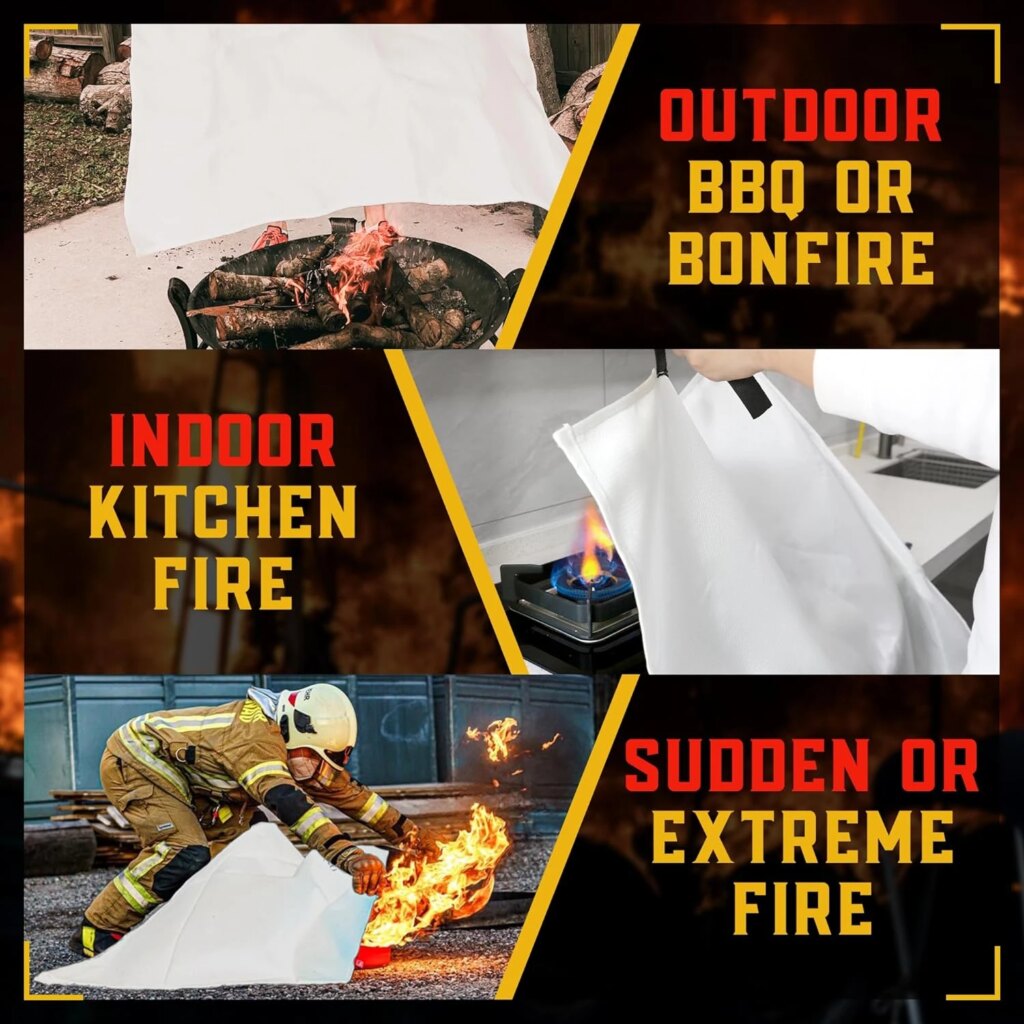Imagine this: You’re preparing a delicious meal, the kitchen filled with enticing aromas when suddenly, a small fire breaks out…
Rather than succumbing to panic, you radiate confidence, armed with the knowledge and the right tools to handle the situation with calm, cool, and grace.
This can be true for anyone who knows how to use a fire blanket correctly.
Understanding fire safety and how to use tools like a fire blanket can make all the difference. In this blog post, we’ll guide you through the proper and safe usage of a fire blanket and give you some tips on how to handle a fire emergency safely using one.
What is a Fire Blanket?
A fire blanket is a simple yet crucial tool in fire safety, designed specifically to smother small fires before they escalate. Made from woven fire-resistant material like woven fiberglass, fire blankets are capable of cutting off oxygen, effectively extinguishing the flames.
While fire blankets are commonly associated with kitchen fires, their utility extends beyond just that. This versatility makes them suitable for various household fires, including clothing fires and minor electrical fires.
Know When to Use a Fire Blanket
Fire blankets are most effective for smothering small fires that have just started or are in their early stages. They are particularly suitable for Class F fires, which involve cooking fats and oils. This is because fire blankets are crafted from fire-retardant materials specifically designed to combat Class F fires. Traditional fire extinguishers are ineffective against these types of flames due to the extremely high temperatures that fats and oils can reach during combustion.
Understanding the types of fires a fire blanket can handle is essential in ensuring its effective use. For instance, a fire blanket is not suitable for grease fires in deep fryers, as the risk of splattering hot oil can exacerbate the situation. They are also unsuitable for large or spreading fires, as they may not be able to contain the flames and can pose a risk of getting burned. By recognizing these distinctions, you can respond more effectively to various fire scenarios, ensuring the safety of your home.

Difference Between Fire Blanket and Fire Extinguisher
While both are essential tools in fire safety, fire blankets and extinguishers serve different purposes.
- Fire blankets work by smothering the flames, while fire extinguishers use agents like water or chemicals to suppress and put out fires.
- Fire blankets are a one-time use tool and may not be effective for larger fires, while fire extinguishers can often be recharged and used multiple times.
- When used, fire blankets do not leave behind any residue. In contrast, most fire extinguishers leave behind some form of residue depending on the extinguishing agent used. For instance, dry chemical extinguishers can leave a chalky residue that requires thorough clean-up, while foam extinguishers may leave a soapy residue.
How to Safely Use a Fire Blanket
Using a fire blanket might seem straightforward, but following the correct steps is crucial for ensuring safety and effectiveness. Here’s a step-by-step guide:
- Assess the situation: Before approaching the fire, quickly evaluate its size and type. Ensure it’s safe to use a fire blanket—if the fire is too large or spreading quickly, evacuate the area and call emergency services. If possible, turn off the heat source, such as an oven or stove, to reduce the risk of the fire spreading. Additionally, turn off any space heater as a common household heat source.
- Grab the fire blanket: Locate your fire blanket; it’s often stored in a box or holder on the wall. Hold it by the top corners, ensuring the tabs hanging from the packaging are pulled down to release the blanket, allowing for easy deployment.
- Shield yourself: As you approach the fire, release the fire blanket, protecting yourself and holding the blanket in front of you. This helps shield against flames and heat. We also recommend wearing flame-retardant gloves if available.
- Smother the flames: Gently place the blanket over the flames without throwing it (to avoid fanning the fire). Ensure the blanket completely covers the fire and extends beyond the edges to contain it.
- Wait and monitor: Leave the blanket in place for at least 30 minutes to ensure that the fire is fully extinguished. Do not remove the blanket too early, as the fire may reignite.
- Check for remaining heat: After allowing sufficient time, carefully check for any remaining heat or signs of fire. If you suspect the fire is still smoldering, do not hesitate to call for professional help.
- Dispose of the fire blanket properly: If the blanket was used before, it would need to be disposed of according to local regulations. Replace it with a new fire blanket to ensure preparedness for future emergencies.
- Call the Fire Department: If the fire is significant, or you’re not confident that it has been fully extinguished, don’t hesitate to call emergency services for help.
By following these steps, you can use a fire blanket effectively and safely in an emergency, helping to protect yourself and your surroundings from fire hazards.
Additional Safety Tips
- Regularly check your fire blanket: Just like any other tool, a fire blanket must be in good condition and easily accessible. Regularly inspect it to ensure there are no tears or damage that can affect its effectiveness.
- Teach others how to use it: It’s essential to educate everyone in your household on how to properly use a fire blanket in case of an emergency. This includes children and elderly members who may need help during an evacuation.
- Have multiple fire blankets conveniently placed: Having more than one fire blanket in your home is always a good idea, especially if you have a larger house or multiple floors. Place them in easily accessible locations, such as the kitchen, and near potential fire hazards like fireplaces or electrical appliances.
- Consider having a training session: For workplaces or establishments that handle potentially hazardous materials, it’s crucial to conduct regular training sessions on how to use a fire blanket and other safety protocols.

Benefits of Having a Fire Blanket at Home
Having a fire blanket as part of your home’s safety equipment offers unparalleled peace of mind. Whether you’re an avid cook or simply safety-conscious, fire blankets provide a swift response to unexpected kitchen fires, ensuring flames are swiftly and effectively extinguished. This quick intervention can prevent costly damages, injuries, or even fatalities. Here’s why having a fire blanket at home is beneficial:
- Ease of use: They require no specialized training to operate, making them accessible to anyone in the household.
- Quick response: Fire blankets offer a fast and immediate response to small fires, making them crucial in preventing flames from spreading and causing further damage.
- No Residue left behind: Unlike many fire extinguishers, fire blankets do not leave a messy residue, reducing the clean-up required after a fire incident.
- No maintenance required: Unlike fire extinguishers that require regular checks and maintenance, a fire blanket only needs to be replaced if used or damaged.
- Compact and portable: Fire blankets are lightweight and can be easily stored in convenient locations, ensuring they are readily accessible during an emergency.
- Cost-effective safety measures: They are generally affordable and can provide peace of mind by potentially preventing the loss of property and a reduction in fire-related injuries.
- Versatile application: Fire blankets can be used on various types of fires, including those caused by cooking and electrical appliances, which makes them a valuable addition to any safety toolkit.
- Promotes fire safety awareness: Having a fire blanket at home encourages families to discuss and implement fire safety measures, ultimately fostering a culture of preparedness.
Beyond protecting property, fire blankets play a vital role in safeguarding you and your loved ones from injury. In cases where clothing catches fire, a fire blanket can be used to wrap the person and suppress the flames, minimizing burns and other injuries.
Furthermore, incorporating a fire blanket into your home safety toolkit complements other fire prevention measures, such as smoke detectors and fire extinguishers. The combination of these tools provides a comprehensive defense against potential fire hazards, enhancing overall safety and preparedness.
Best Practices for Fire Blanket Maintenance
Proper maintenance is crucial to ensure your fire blanket is prepared for emergencies. Begin by choosing a convenient and accessible location for storage, ideally near high-risk areas such as the kitchen. Ensure it is visible and easily reachable, allowing for quick access when needed.
It’s also important to regularly inspect your fire blanket for signs of wear and tear, such as fraying edges or damage from exposure to heat and moisture. These factors can compromise its effectiveness, so prompt replacement is necessary if any issues are identified. Remember to review the manufacturer’s instructions on properly using and caring for your fire blanket to ensure it remains in good working condition.
Additionally, consider investing in a fire safety training session for you and your household. Familiarize everyone with the location of the fire blanket and how to use it effectively during various fire scenarios. This proactive approach fosters a culture of safety and preparedness, equipping each household member with the knowledge and skills to respond confidently to potential fire threats.
FAQs
Q: Do I need to replace my fire blanket after using it?
A: Yes, once a fire blanket has been used, it should be replaced immediately. The high temperatures from the flames can damage the material, compromising its effectiveness in future incidents.
Q: Can I reuse a damaged fire blanket?
A: No, any damage to a fire blanket can affect its ability to smother flames effectively. It’s best to replace a damaged fire blanket immediately.
Q: What materials are fire blankets typically made from?
A: Fire blankets are generally made from non-flammable materials such as fiberglass, wool, or a combination of both. These materials are designed to withstand high temperatures and prevent the spread of flames.
Q: When should I seek medical assistance?
A: If you or anyone else has been injured in a fire incident, seek medical attention immediately. Even if the injuries seem minor, it’s essential to have them checked by a medical professional to prevent any potential complications.
Stay Prepared: Invest in Fire Safety Today!
Now that you’re equipped with essential fire safety knowledge, take the next step by reviewing your home’s fire safety measures. Consider integrating fire blankets with other preventive tools, such as smoke alarms and fire extinguishers, to create a comprehensive safety net.
It’s essential that you invest in high-quality fire blankets like those available at Mart Cobra. We offer a range of fire blankets that meet safety standards and provide peace of mind in case of emergencies. Backed by thousands of positive user reviews, our 100% fiberglass flame retardant fabric removes the oxygen supply to smother the fire quickly.
Visit our website today to learn more about our fire blankets and other fire safety products. Remember, it’s better to be prepared and never have to use your emergency tools than not to have them when you need them the most.

0 comments